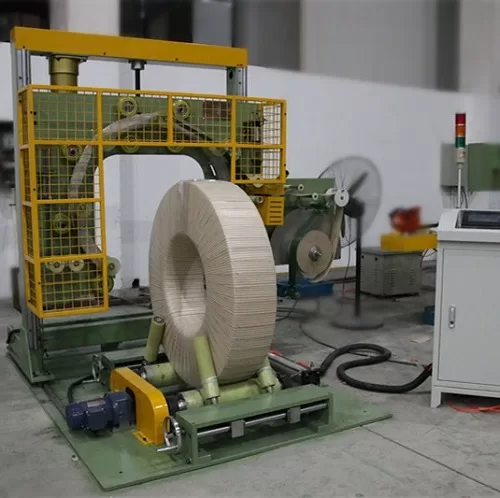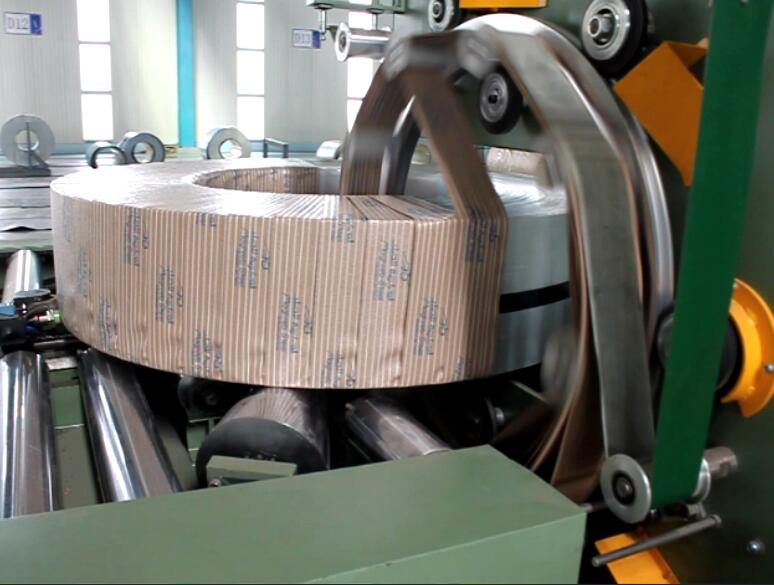Optimizing Protection and Handling: A Guide to Wire Packing and Coil Wrapping Machines
Protecting wire bundles and large coils during storage and transit is crucial in industries ranging from metal production to telecommunications. Damage from handling, moisture, or corrosion can lead to significant losses. Wire packing machines and coil wrapping machines provide automated solutions to securely package these materials, ensuring they arrive at their destination in optimal condition. This guide explores the functionality, benefits, and key considerations for these essential pieces of industrial equipment.
Understanding Wire Packing Machines
Wire packing machines are specifically designed to bundle and wrap linear wire products, cables, or smaller coiled items like hoses or tubes.

Core Functionality
These machines typically consolidate loose strands or pre-coiled wire bundles and apply a protective wrapping material. The process often involves:
- Feeding the wire bundle into the wrapping station.
- Applying materials such as plastic film, stretch wrap, woven tape, or specialized paper around the bundle.
- Securing the wrap tightly to prevent unwinding and provide protection.
- Automated cutting and sealing of the wrapping material.
Key Benefits
- Product Protection: Shields wires and cables from dust, moisture, abrasion, and tangling.
- Improved Handling: Creates stable, unitized bundles that are easier to handle, store, and transport.
- Organization: Keeps wires neatly packaged, simplifying inventory management.
- Efficiency: Automates a labor-intensive process, increasing throughput and consistency.
Understanding Coil Wrapping Machines
Coil wrapping machines, often utilizing an orbital wrapping technique, are built to handle larger, heavier coiled materials, particularly metal coils (steel, aluminum, copper) but also potentially paper or plastic coils.
Core Functionality
The hallmark of these machines is typically a rotating ring or shuttle that carries the wrapping material (like stretch film, VCI paper, or HDPE) and passes it through the eye of the coil as the coil itself may rotate. This 'orbital' motion ensures complete coverage around the coil's circumference and faces. Key features often include:
- Robust loading and unloading systems (e.g., conveyors, tilters).
- Precise tension control for a tight, secure wrap.
- Compatibility with various protective materials, including Volatile Corrosion Inhibitor (VCI) paper or film for metal protection. Learn more about VCI technology from an [authoritative source on corrosion prevention]
- Programmable Logic Controllers (PLCs) for customizing wrapping patterns and cycles.
Key Benefits
- Corrosion Prevention: Essential for metal coils, especially when using VCI materials.
- Damage Protection: Guards against scratches, dents, and contamination during handling and shipping.
- Load Stability: Secures the coil tightly, preventing shifting during transit.
- Safety: Reduces manual handling risks associated with large, heavy coils. Relevant safety guidelines can be found via resources like [OSHA]).

coil wrapping machine The Wrapping Process in Action
Modern wire and coil wrapping machines incorporate significant automation. While specific operations vary, a typical automated cycle involves loading the product onto the machine, initiating the wrap cycle via a control interface, the automated application and cutting of the wrapping material, and finally, unloading the securely packaged product.
The video below demonstrates a coil packing solution utilizing materials like paper, stretch film, and PET strapping.
Key Considerations When Selecting Equipment
Choosing the right machine depends heavily on specific operational needs. Factors include:
- Product Dimensions & Weight: Machine capacity must match the size (diameter, width) and weight of the wires or coils.
- Required Throughput: Wrapping speed (e.g., coils per hour) needs to align with production rates.
- Wrapping Material: Ensure compatibility with necessary materials (stretch film, VCI, paper, woven fabric).
- Level of Automation: Decide between semi-automatic or fully automated systems based on labor availability and desired efficiency.
- Footprint and Utilities: Consider available floor space and power requirements (e.g., voltage, phase).
- Safety Features: Look for essential safety mechanisms like emergency stops, safety guards, and light curtains.
Typical Technical Specifications
Specifications vary widely based on the machine's intended application and design. Below are parameters for a representative automated wrapping machine configuration:
- Machine Type: Automated Wire and Coil Wrapping Machine
- Compatible Product OD: 500mm - 1800mm (Example range)
- Compatible Product ID: 300mm - 1500mm (Example range)
- Compatible Product Width: 100mm - 800mm (Example range)
- Maximum Product Weight: Up to 5000kg (Example)
- Wrapping Material Compatibility: Stretch Film (LLDPE), VCI Paper, Crepe Paper, Woven Fabric
- Wrapping Speed: Variable, dependent on coil size and wrap pattern (e.g., 5-20 coils/hour)
- Power Requirements: Typically 480V, 60Hz, 3-Phase (confirm based on region)
- Control System: PLC with HMI (Touchscreen Display)
- Features: Adjustable Material Tension Control, Automatic Material Cutting & Clamping
- Safety: Emergency Stop Circuits, Interlocked Guarding
Note: These parameters illustrate a potential configuration. Exact specifications must be confirmed based on the specific model and application requirements. Consulting with equipment manufacturers is essential to determine the best fit.
Applications Across Industries
Wire packing and coil wrapping machines are indispensable in various sectors:
- Steel Industry: Preparing heavy steel coils for storage or shipment, often requiring robust wrapping with VCI materials to prevent rust during long transit times or storage in variable environments. Solutions may include a wire coil strapping machine in conjunction with wrapping.
- Wire & Cable Manufacturing: Bundling and protecting electrical wires, data cables, and fiber optics. Wrapping prevents tangling, protects insulation, and ensures products meet quality standards upon delivery. A dedicated wire coil wrapping machine is often used here.
- Aluminum Industry: Wrapping aluminum coils used in automotive, aerospace, and construction. Protection against surface damage (scratches, oxidation) is critical for maintaining material integrity and aesthetic quality.
- Non-Ferrous Metals: Packaging copper coils, brass strips, and other valuable metals where surface quality and protection from environmental factors are paramount.
- Other Materials: Applicable also for coils of paper, plastic film, textiles, or even tires, where secure unitization and protection are needed.

packing material for coil wrapping machine Maintaining Your Wrapping Equipment
To ensure longevity, reliability, and optimal performance:
- Regular Cleaning: Keep the machine free of dust, debris, and wrapping material residue.
- Lubrication: Follow manufacturer guidelines for lubricating moving parts like bearings and chains.
- Inspect Wear Parts: Regularly check rollers, belts, cutting blades, and wrapping ring components for wear and tear.
- Check Electrical Connections: Ensure wiring and control panel components are secure and functioning correctly.
- Operator Training: Properly trained operators are less likely to cause accidental damage and can spot potential issues early.
Conclusion
Wire packing machines and coil wrapping machines are vital investments for manufacturers and processors dealing with wire, cable, and coiled stock. By automating the packaging process, they enhance product protection, improve handling efficiency, ensure load stability, and contribute to overall operational safety and productivity. Selecting the appropriate machine based on careful consideration of product characteristics, throughput needs, and required protective materials is key to maximizing these benefits.

